2007 CHEVROLET MALIBU fuel
[x] Cancel search: fuelPage 2 of 510
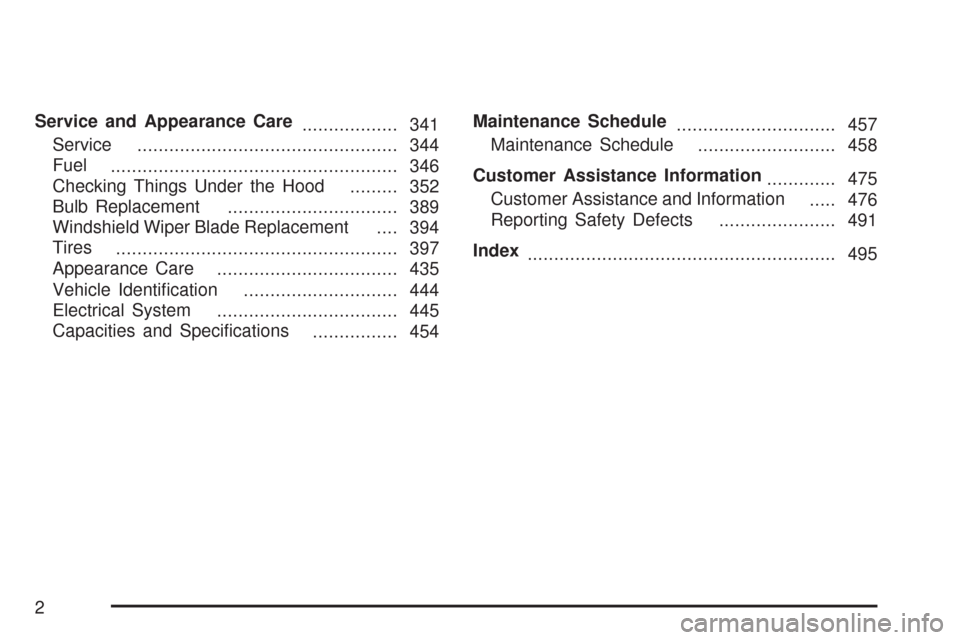
Service and Appearance Care
.................. 341
Service
................................................. 344
Fuel
...................................................... 346
Checking Things Under the Hood
......... 352
Bulb Replacement
................................ 389
Windshield Wiper Blade Replacement
.... 394
Tires
..................................................... 397
Appearance Care
.................................. 435
Vehicle Identi�cation
............................. 444
Electrical System
.................................. 445
Capacities and Speci�cations
................ 454Maintenance Schedule
.............................. 457
Maintenance Schedule
.......................... 458
Customer Assistance Information
............. 475
Customer Assistance and Information
..... 476
Reporting Safety Defects
...................... 491
Index
.......................................................... 495
2
Page 101 of 510
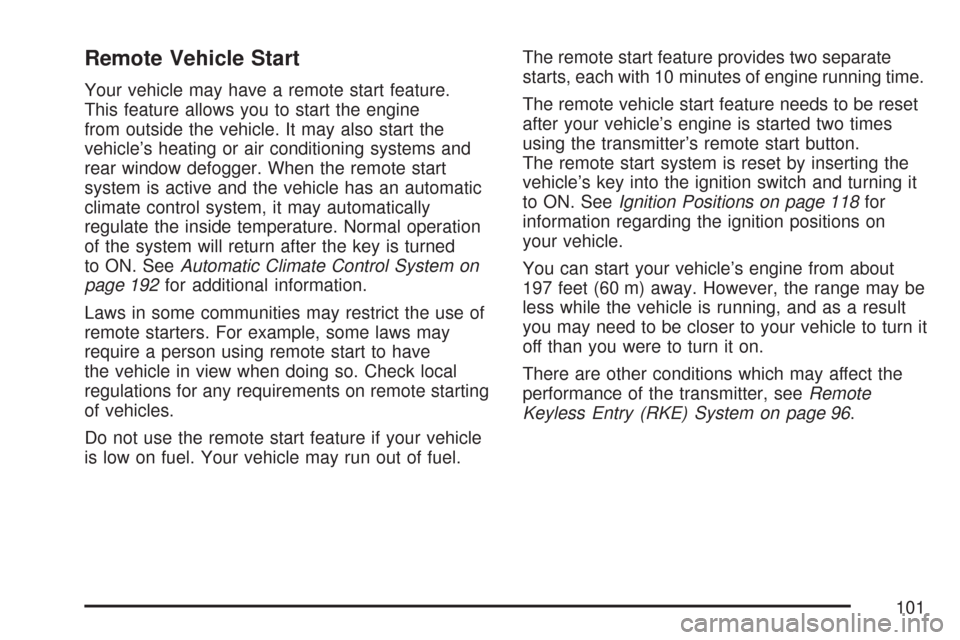
Remote Vehicle Start
Your vehicle may have a remote start feature.
This feature allows you to start the engine
from outside the vehicle. It may also start the
vehicle’s heating or air conditioning systems and
rear window defogger. When the remote start
system is active and the vehicle has an automatic
climate control system, it may automatically
regulate the inside temperature. Normal operation
of the system will return after the key is turned
to ON. SeeAutomatic Climate Control System on
page 192for additional information.
Laws in some communities may restrict the use of
remote starters. For example, some laws may
require a person using remote start to have
the vehicle in view when doing so. Check local
regulations for any requirements on remote starting
of vehicles.
Do not use the remote start feature if your vehicle
is low on fuel. Your vehicle may run out of fuel.The remote start feature provides two separate
starts, each with 10 minutes of engine running time.
The remote vehicle start feature needs to be reset
after your vehicle’s engine is started two times
using the transmitter’s remote start button.
The remote start system is reset by inserting the
vehicle’s key into the ignition switch and turning it
to ON. SeeIgnition Positions on page 118for
information regarding the ignition positions on
your vehicle.
You can start your vehicle’s engine from about
197 feet (60 m) away. However, the range may be
less while the vehicle is running, and as a result
you may need to be closer to your vehicle to turn it
off than you were to turn it on.
There are other conditions which may affect the
performance of the transmitter, seeRemote
Keyless Entry (RKE) System on page 96.
101
Page 115 of 510
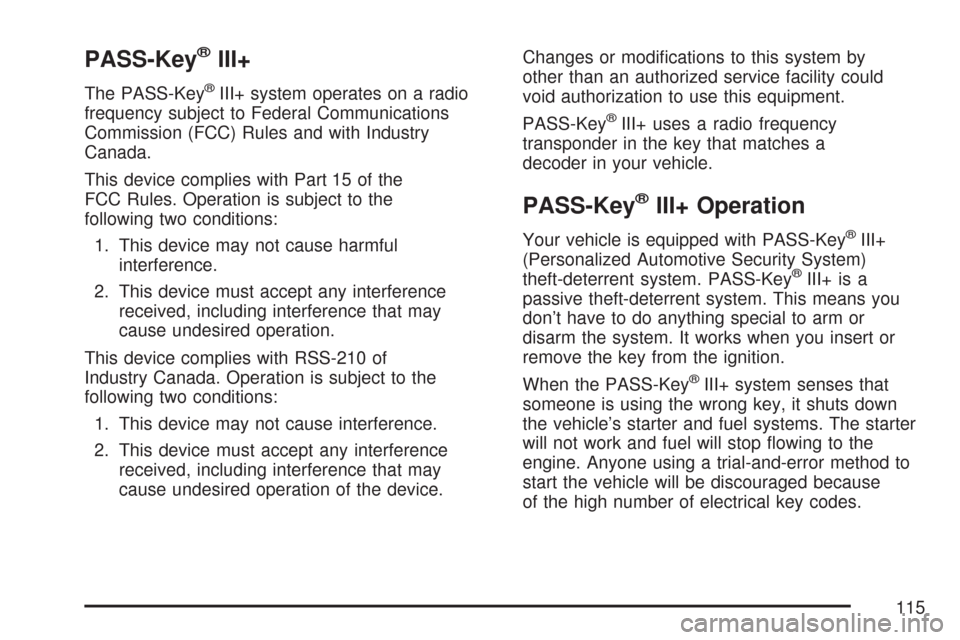
PASS-Key®III+
The PASS-Key®III+ system operates on a radio
frequency subject to Federal Communications
Commission (FCC) Rules and with Industry
Canada.
This device complies with Part 15 of the
FCC Rules. Operation is subject to the
following two conditions:
1. This device may not cause harmful
interference.
2. This device must accept any interference
received, including interference that may
cause undesired operation.
This device complies with RSS-210 of
Industry Canada. Operation is subject to the
following two conditions:
1. This device may not cause interference.
2. This device must accept any interference
received, including interference that may
cause undesired operation of the device.Changes or modi�cations to this system by
other than an authorized service facility could
void authorization to use this equipment.
PASS-Key
®III+ uses a radio frequency
transponder in the key that matches a
decoder in your vehicle.
PASS-Key®III+ Operation
Your vehicle is equipped with PASS-Key®III+
(Personalized Automotive Security System)
theft-deterrent system. PASS-Key
®III+ is a
passive theft-deterrent system. This means you
don’t have to do anything special to arm or
disarm the system. It works when you insert or
remove the key from the ignition.
When the PASS-Key
®III+ system senses that
someone is using the wrong key, it shuts down
the vehicle’s starter and fuel systems. The starter
will not work and fuel will stop �owing to the
engine. Anyone using a trial-and-error method to
start the vehicle will be discouraged because
of the high number of electrical key codes.
115
Page 122 of 510
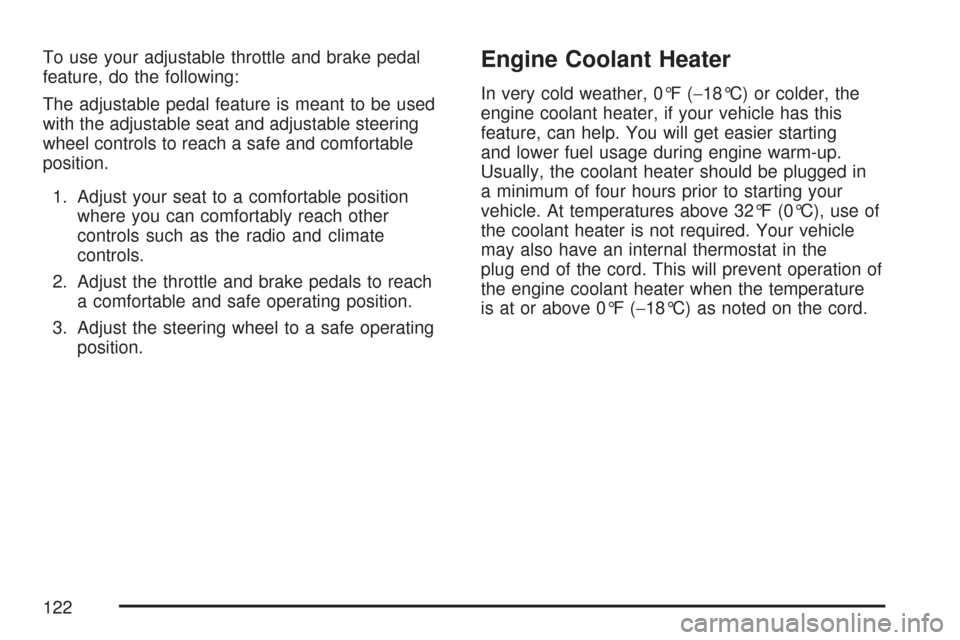
To use your adjustable throttle and brake pedal
feature, do the following:
The adjustable pedal feature is meant to be used
with the adjustable seat and adjustable steering
wheel controls to reach a safe and comfortable
position.
1. Adjust your seat to a comfortable position
where you can comfortably reach other
controls such as the radio and climate
controls.
2. Adjust the throttle and brake pedals to reach
a comfortable and safe operating position.
3. Adjust the steering wheel to a safe operating
position.Engine Coolant Heater
In very cold weather, 0°F (−18°C) or colder, the
engine coolant heater, if your vehicle has this
feature, can help. You will get easier starting
and lower fuel usage during engine warm-up.
Usually, the coolant heater should be plugged in
a minimum of four hours prior to starting your
vehicle. At temperatures above 32°F (0°C), use of
the coolant heater is not required. Your vehicle
may also have an internal thermostat in the
plug end of the cord. This will prevent operation of
the engine coolant heater when the temperature
is at or above 0°F (−18°C) as noted on the cord.
122
Page 126 of 510
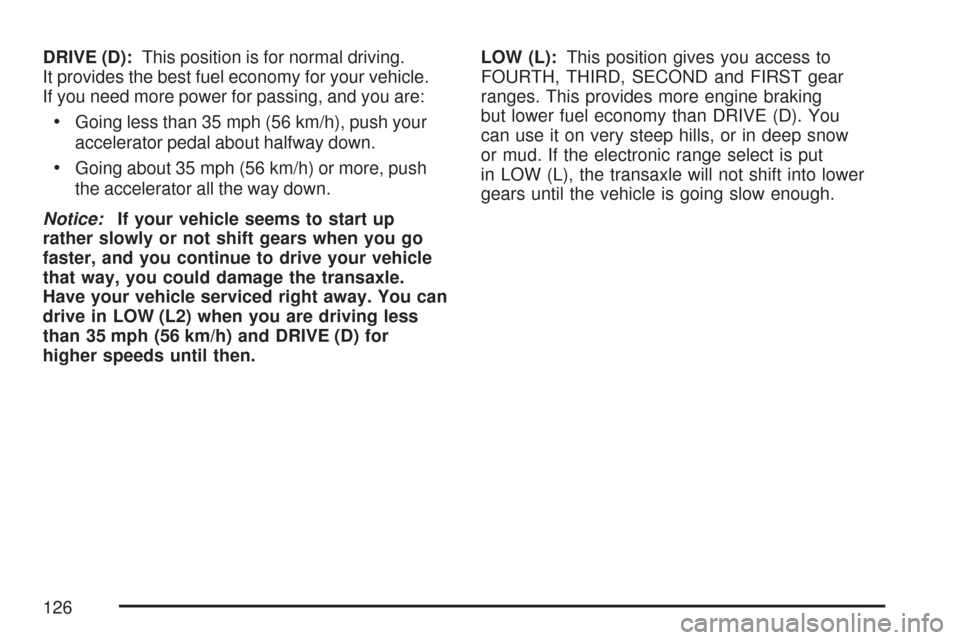
DRIVE (D):This position is for normal driving.
It provides the best fuel economy for your vehicle.
If you need more power for passing, and you are:
Going less than 35 mph (56 km/h), push your
accelerator pedal about halfway down.
Going about 35 mph (56 km/h) or more, push
the accelerator all the way down.
Notice:If your vehicle seems to start up
rather slowly or not shift gears when you go
faster, and you continue to drive your vehicle
that way, you could damage the transaxle.
Have your vehicle serviced right away. You can
drive in LOW (L2) when you are driving less
than 35 mph (56 km/h) and DRIVE (D) for
higher speeds until then.LOW (L):This position gives you access to
FOURTH, THIRD, SECOND and FIRST gear
ranges. This provides more engine braking
but lower fuel economy than DRIVE (D). You
can use it on very steep hills, or in deep snow
or mud. If the electronic range select is put
in LOW (L), the transaxle will not shift into lower
gears until the vehicle is going slow enough.
126
Page 127 of 510
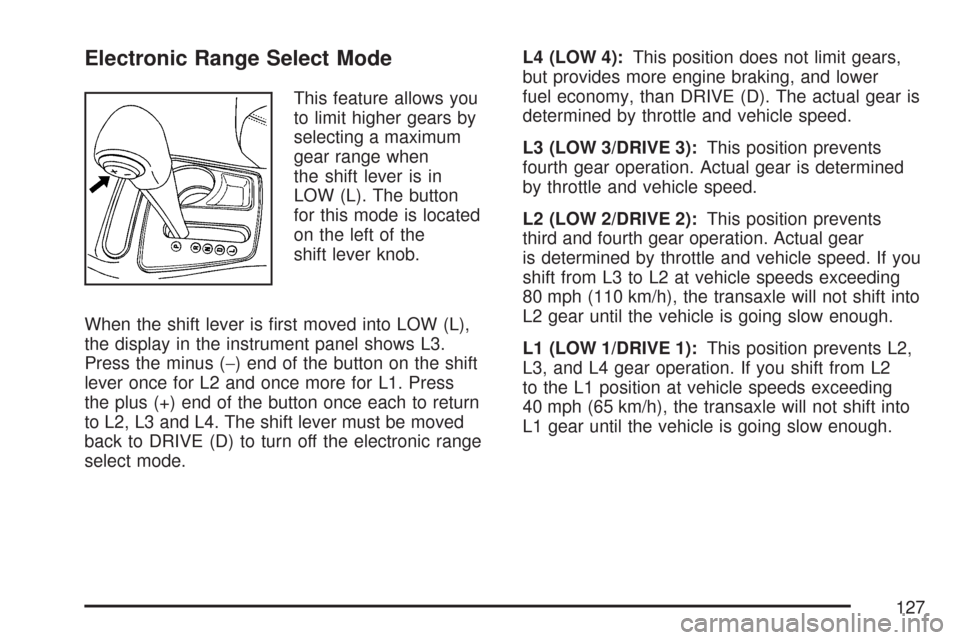
Electronic Range Select Mode
This feature allows you
to limit higher gears by
selecting a maximum
gear range when
the shift lever is in
LOW (L). The button
for this mode is located
on the left of the
shift lever knob.
When the shift lever is �rst moved into LOW (L),
the display in the instrument panel shows L3.
Press the minus (−) end of the button on the shift
lever once for L2 and once more for L1. Press
the plus (+) end of the button once each to return
to L2, L3 and L4. The shift lever must be moved
back to DRIVE (D) to turn off the electronic range
select mode.L4 (LOW 4):This position does not limit gears,
but provides more engine braking, and lower
fuel economy, than DRIVE (D). The actual gear is
determined by throttle and vehicle speed.
L3 (LOW 3/DRIVE 3):This position prevents
fourth gear operation. Actual gear is determined
by throttle and vehicle speed.
L2 (LOW 2/DRIVE 2):This position prevents
third and fourth gear operation. Actual gear
is determined by throttle and vehicle speed. If you
shift from L3 to L2 at vehicle speeds exceeding
80 mph (110 km/h), the transaxle will not shift into
L2 gear until the vehicle is going slow enough.
L1 (LOW 1/DRIVE 1):This position prevents L2,
L3, and L4 gear operation. If you shift from L2
to the L1 position at vehicle speeds exceeding
40 mph (65 km/h), the transaxle will not shift into
L1 gear until the vehicle is going slow enough.
127
Page 130 of 510
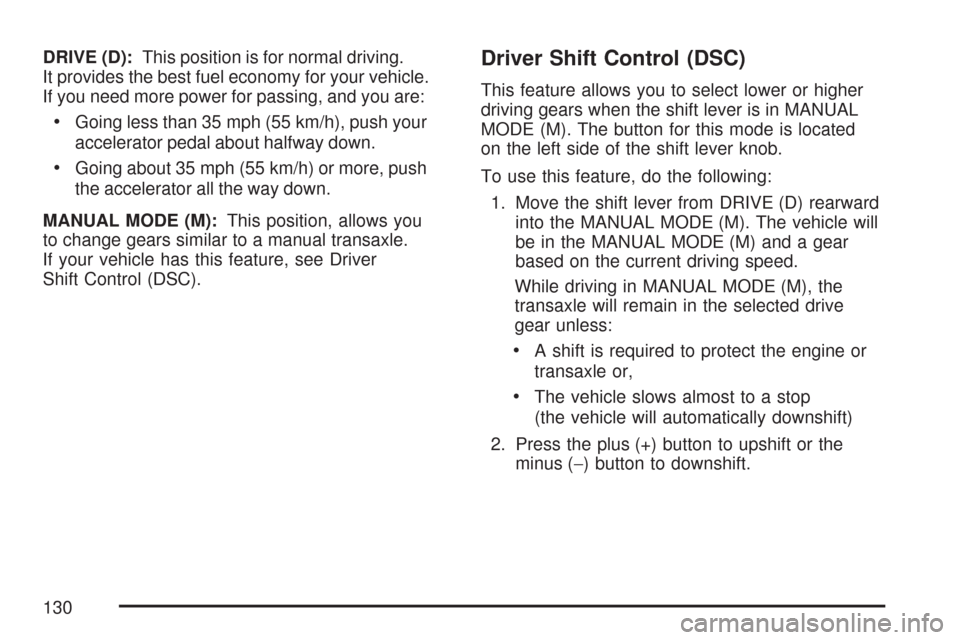
DRIVE (D):This position is for normal driving.
It provides the best fuel economy for your vehicle.
If you need more power for passing, and you are:
Going less than 35 mph (55 km/h), push your
accelerator pedal about halfway down.
Going about 35 mph (55 km/h) or more, push
the accelerator all the way down.
MANUAL MODE (M):This position, allows you
to change gears similar to a manual transaxle.
If your vehicle has this feature, see Driver
Shift Control (DSC).
Driver Shift Control (DSC)
This feature allows you to select lower or higher
driving gears when the shift lever is in MANUAL
MODE (M). The button for this mode is located
on the left side of the shift lever knob.
To use this feature, do the following:
1. Move the shift lever from DRIVE (D) rearward
into the MANUAL MODE (M). The vehicle will
be in the MANUAL MODE (M) and a gear
based on the current driving speed.
While driving in MANUAL MODE (M), the
transaxle will remain in the selected drive
gear unless:
A shift is required to protect the engine or
transaxle or,
The vehicle slows almost to a stop
(the vehicle will automatically downshift)
2. Press the plus (+) button to upshift or the
minus (−) button to downshift.
130
Page 166 of 510
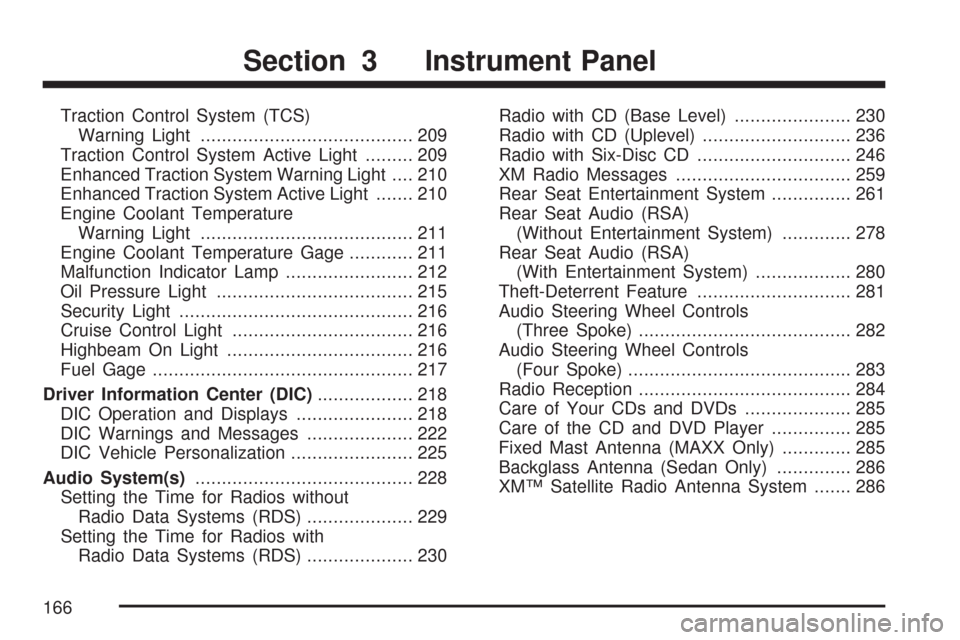
Traction Control System (TCS)
Warning Light........................................ 209
Traction Control System Active Light......... 209
Enhanced Traction System Warning Light.... 210
Enhanced Traction System Active Light....... 210
Engine Coolant Temperature
Warning Light........................................ 211
Engine Coolant Temperature Gage............ 211
Malfunction Indicator Lamp........................ 212
Oil Pressure Light..................................... 215
Security Light............................................ 216
Cruise Control Light.................................. 216
Highbeam On Light................................... 216
Fuel Gage................................................. 217
Driver Information Center (DIC).................. 218
DIC Operation and Displays...................... 218
DIC Warnings and Messages.................... 222
DIC Vehicle Personalization....................... 225
Audio System(s)......................................... 228
Setting the Time for Radios without
Radio Data Systems (RDS).................... 229
Setting the Time for Radios with
Radio Data Systems (RDS).................... 230Radio with CD (Base Level)...................... 230
Radio with CD (Uplevel)............................ 236
Radio with Six-Disc CD............................. 246
XM Radio Messages................................. 259
Rear Seat Entertainment System............... 261
Rear Seat Audio (RSA)
(Without Entertainment System)............. 278
Rear Seat Audio (RSA)
(With Entertainment System).................. 280
Theft-Deterrent Feature............................. 281
Audio Steering Wheel Controls
(Three Spoke)........................................ 282
Audio Steering Wheel Controls
(Four Spoke).......................................... 283
Radio Reception........................................ 284
Care of Your CDs and DVDs.................... 285
Care of the CD and DVD Player............... 285
Fixed Mast Antenna (MAXX Only)............. 285
Backglass Antenna (Sedan Only).............. 286
XM™ Satellite Radio Antenna System....... 286
Section 3 Instrument Panel
166